Bichon Frise
 Bichon Frise
Bichon Frise
Members of the Bichon family are complete extroverts, a joy to live with and well suited to modern society. Bichons are comparatively recent additions to the pure breed dog world, resurrected from virtual extinction. With controversy surrounding their ancient history, a few facts are presented here in the hope that the typical coat of each variety will not be dissipated by modern show ring grooming techniques.
The Little Barbet
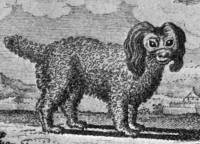 Small Barbet
Small Barbet
On the left is a drawing of a 'Little Barbet' or Bichon which French Georges Buffon described as the combination of the small sized ancient French water dog, the Barbet, and the Spirit Lion dog of China. In 1760 Buffon was the first to call these dogs 'Bichons' when he described them as 'mongrels between a small Spanish dog and a little Barbet'[5]. Remembering the French and Spanish borders were forever changing over the years, the Little Barbet certainly forms the basis of the entire Bichon family.
History of the Bichon Frise
The Bichon Frise of France is the first of three Bichon varieties we shall consider here. As explained in the History of Companion Dogs, these small white dogs travelled from Tenerife in the Canary Islands accompanying Spanish seamen along trade routes to destinations where the dogs were traded.
The first known Bichons were named the Bichon Tenerife after one of the Canary Islands from whence they came. These small white dogs were first mentioned in French Literature during the 1500's. Mostly 'house dogs' and favourites with women and children, they had a distinct type by the time they were popularized by Napoleon Bonaparte. From 1848-1870 he was President of France and later its Emperor. By 1900 this little dog's extroverted personality, ability to be trained to stand on its hind legs, combined with its happy disposition made it popular as a performing dog in circuses.
Sadly, this type of dog was reduced to minimal numbers during World War One.
 Bichon Frise (Australia)
Bichon Frise (Australia)
The Bichon Frise becomes a Pure Breed
Resurrected in France by the 'Friends of the Belgium Breeds' and the President of the the Toy Dog Club and a few enthusiasts, they produced a Breed Standard, naming them the 'Bichon Tenerife'. In 1933 the Société Central of France renamed the breed the 'Bichon à Poil Frisé', translated as 'the Curly Bichon' and admitted them to the French Stud Book and listed as a French/Belgium breed.
World War Two again reduced the European Bichons to such low numbers, once more they faced extinction. But in 1957, they were imported into UK and recognised by the Kennel Club UK in 1974[6].
Fortunately also some had been exported to USA in the 1930's. These, combined with dogs of unknown parentage that were accepted as Bichon Frise by the European FCI as late as 1969, provided the world with the basis of the breed we know today[1]. It was recognised as a pure breed by the American Kennel Club 1972, with the first Bichon arriving here in Australia from USA in 1976.
The Bichon Frise, Havanese and Coton de Tulear Today
All 3 of these breeds were bred purely as as companions although the Coton is more protective of its family than the other two. The main difference between these three is their coat. The 'soft corkscrew curls' demanded by the Bichon Frise Breed Standard are brushed out and this presentation is generally accepted in today's show rings. But if the coat is parted, evidence of these curls is seen by soft crinkles in the coat which look something like a crinkle cut potato crisp viewed in profile which enables the coat to stand off the body and be trimmed and shaped[4].
| Bichon Frise | Havanese | Coton de Tulear | |
|---|---|---|---|
| Coat | The coat of the Bichon Frise should be fine and silky, with soft corkscrew curls. It should not be flat or corded, and should measure around 7-10 cm in length. It may be presented untrimmed or have muzzle and feet tidied up. | The soft, flat or wavy topcoat is very long - 12-18 cm [4.5-7 ins] in an adult dog, which may contain curly strands. Sometimes it is a double coat with a woolly undercoat. There should be no trimming of the body coat but the feet may be tidied up. |
As the Coton's name suggests, its dense, profuse coat should have the texture of cotton. It may be slightly wavy but it is very soft and supple and never hard or rough. |
| Colour | Pure white coat. It is preferable that the skin has dark pigment with black, blue or beige markings. | The Havanese is rarely completely pure white. It may be fawn or tan in its different shades or with a slight blackened overlay, black, havana-brown, tobacco colour or reddish brown. It may also come with patches of any of the above mentioned colours. | The Coton is basically white. There may be a few slight shadings of a mixture of white and black or fawn hairs on the ears. These shadings are also tolerated but not preferred on the body if they do not alter the general appearance of white coat. |
| Height | Height: Less than 30 cm (11.8 in), smallness being highly desirable. | Height: 23 to 27 cm [9 -10.5 in] Tolerance from 21 to 29 cm [8-11.5 in] |
Males : 26-28 cm (10 - 11 in) |
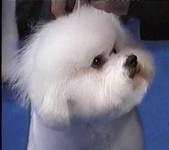 Bichon Frise Bichon Frise |
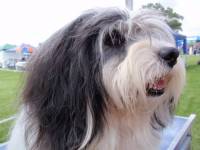 Havanese Havanese |
|
|
| Head Proportions | The skull is definitely longer than the muzzle | The skull should be approximately the same length as the muzzle | The skull should be a little longer than the muzzle than the Bichon |
| Skull | The skull is flat but can look round because of the trimming of the hair | The skull is broad and flat but looking from above, rounded at the back and almost straight and square on the other three sides. | The slightly rounded skull is rather wide in relation to its length |
| Stop | Slight with the hollow between the eyes just visible | Moderately marked | Slight |
| Muzzle | The lips should be tight, fine and like the nose, completely black | Narrowing slightly towards the eyes but not snipey with nose colour black or brown, consistent with the coat colour | Straight with fine tight lips with nose colour consistent with the coat colour |
| Eyes | The fairly round eyes should be dark with dark eye-rims. They should never be too big, almond shaped, obliquely set or show any white. | The almond shaped eyes are quite big, brown in colour and as dark as possible with a kind expression. The eye rims must be dark brown to black. | The dark, lively eyes are rather rounded and set wide apart. The rims of the eyelids should be well pigmented with black or brown according to the colour of the nose. |
| Ears | The ears are set relatively high but fall along the cheeks forming a discreet fold which raises them slightly. They are covered with long hair fringes. | The ears are set relatively high but are raised by a discreet fold before they fall along the cheeks. They have a discreet fold and end in a lightly rounded point. They are covered with long hair fringes. | Their pendulous, triangular shaped ears are high set on the skull and carried close to the cheeks. They are covered with white hair or with some traces of light grey or fawn hairs. |
| Mouth | Normal scissors bite | Normal scissors bite | Normal scissors bite but may also have a reverse scissors bite. |
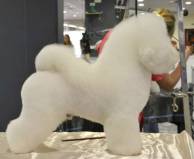 Bichon Frise Bichon Frise |
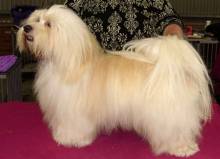 Havanese Havanese |
 Coton de Tulear Coton de Tulear |
|
| Neck | Fairly long and carried proudly | Of medium length | One fifth the length of the body |
| Forequarters | The well-boned forelegs should be straight and parallel, lean & of good bone structure. The distance from the ground to the elbow must not be greater than that between the elbow and the withers. | The lean, straight forelegs should have good bone and be not greater in length than the distance between the elbow and the withers. | Well laid shoulders and straight forelegs approximately the length of the upper arm |
| Hindquarters | The thighs should be broad and well-muscled, with well bent stifles and hocks well let down. | The Havanese should have moderate angulation | The Coton has strongly muscled hindquarters and vertical hocks. There may be dewclaws present. |
| Body | The Bichon has a body the same length as its height at withers. The chest is well developed and the brisket deep and the topline straight. The loin should be broad, well-muscled, and the croup slightly rounded. | The Havanese has a body length slightly longer than its height at withers. The ribs are well sprung and the topline is straight with a slight arch over the loin and a noticeably inclined croup. | The Coton has a body longer than its height at withers. The ribs are well sprung and the back strong. But he has a very slightly convex topline and arch over the loin, which gives him a oblique croup. |
| Feet | Small and rounded with toenails preferably black | Slightly elongated in shape | Small and round with tight toes and pigmented pads |
| Tail | The slightly low set tail of the Bichon is normally carried high, curling gracefully over the back, but never tightly curled. Although it should not actually touch the backbone, the hair should always fall on to the back. | The Havanese's tail is carried high and is furnished with long, silky feathering. It may have either a hook at the end or preferably is carried rolled over the back. | The Coton has a low set tail set as an extension of the spinal column. At rest, it reached the hock but on the move it is carried gaily curved over the back pointing towards the withers. |
| Gait | Although not specified, one would expect a Bichon should move with balanced reach and drive. | The Havanese has a strikingly light-footed, elastic gait. The forelegs move with a free stride, the hind legs giving them the drive to move in a straight line. | The Coton has a free, flowing movement, without covering a lot of ground. Its unusual topline should be retained on the move. |
References and Further Reading
[1] Richard G Beauchamp, 'The Truth About Bichons' Published by The American Cocker Magazine, Midway City CA 92655-1030 USA ISBN 0-9623515-1-2 Chapter 1 'History of the Bichon Frise' Pages 9 - 15
[2] Kathryn Braund, 'The Joyous Havanese' Self Published Chapter 2 'History of the Present Day Hananese and its Ancestors' Pages 9 - 17.
[3] Kris Forke, American Coton Club
[4] John Hutchinson, 'the Bichon Frise - A Comprehensive Study' Chapter 2 Published by Slattery Media Group Australia ISBN 978-1-921778-28-5 Discussion of the Bichon Frise Page 27
- Book Review by Jane Harvey - 'The Bichon Frise - a Comprehensive Study' by John Hutchinson Published in Dog News Australia (Top Dog Media Pty Ltd Austral NSW) Issue 4 January 2018, Page 10
- Also published in 'VicDog Magazine' (Victorian Canine Association Inc.,) Vol 88 September No 9 Page 14
[5] Virginia T Leitch 2nd Edition revised and updated by Dennis Carno - 'The Maltese Dog' Published by IIVS, International Institute of Veterinary Science, New York 1970 Chapter 11 'The origin and development of the Maltese Dog' Pages 5 - 46
[6] Maureen Reynolds, "Our Dogs" Supplement, the A to Z of Breeds', February 12th, 2021, Page 22
